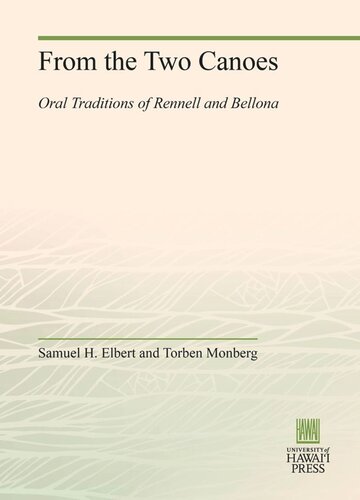

Most ebook files are in PDF format, so you can easily read them using various software such as Foxit Reader or directly on the Google Chrome browser.
Some ebook files are released by publishers in other formats such as .awz, .mobi, .epub, .fb2, etc. You may need to install specific software to read these formats on mobile/PC, such as Calibre.
Please read the tutorial at this link: https://ebookbell.com/faq
We offer FREE conversion to the popular formats you request; however, this may take some time. Therefore, right after payment, please email us, and we will try to provide the service as quickly as possible.
For some exceptional file formats or broken links (if any), please refrain from opening any disputes. Instead, email us first, and we will try to assist within a maximum of 6 hours.
EbookBell Team

4.4
32 reviewsRennell and Bellona are two Polynesian Outlier islands in the British Solomon Islands. The people of Rennell and Bellona often refer to their islands in their rituals and poetry as two canoes. The ancestors who discovered the islands came from the east in two canoes, and the crews of these two canoes laid the foundation for the culture of Rennell and Bellona. Each island, furthermore, is canoe-shaped, with a low-lying interior and high coastal walls not unlike the sides of a canoe.
The first three chapters of this book contain matter designed to make the islanders' traditions given in later chapters more meaningful. Chapter 1 includes brief discussions of the following topics: the field experiences of the two authors (Section 1); a physical description of Rennell and Bellona and a resume of their few contacts with the outside world (Section 2); the social organization, kinship system, religion, and cultural inventory of the people (Section 3); the language, orthography, and translating techniques (Sections 4 to 6); the function of stories and story tellers in the culture (Section 7); the selection and arrangement of the texts (Section 8).
Chapter 2 presents brief biographies of the 49 tellers best known to the compilers, and Chapter 3 consists of genealogies of ancestors and living persons, from the first immigrants down through some 23 generations to the children of the present chiefs.
In Chapters 4 through 19 the traditions of the Rennellese and Bellonese are given in their own words, with our translations into English in parallel columns. The traditions are not presented here in the order in which they were told in the field, which depended on the knowledge and moods of 72 informants, but have been rearranged in the following historical-semantic order: the gods and the semimythical early inhabitants; the immigration of the ancestors of the present-day people from a place called 'Ubea; the formation of settlements and clans and subdivisions of clans, and the nearly constant fighting and strife; the vicissitudes and doings of ordinary folk, and the arrivals of castaways from other islands; finally, the conversion to Christianity in 1938 with its traumatic events at Niupani.